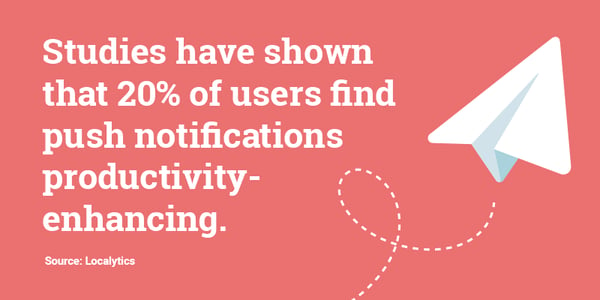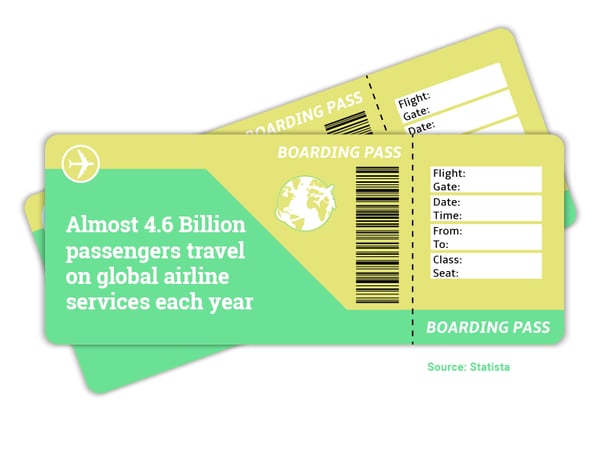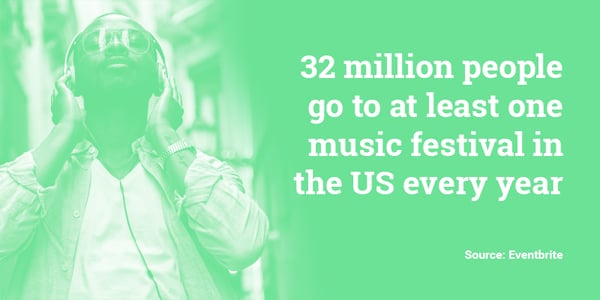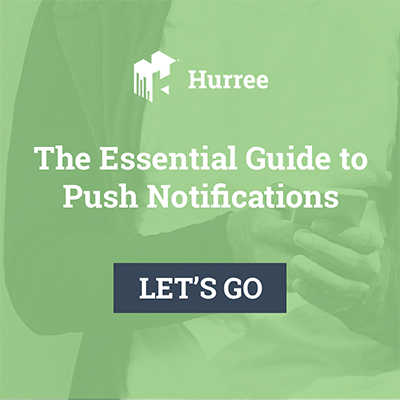3 Industries Boosting UX With Informative Push Notifications
When was the last time someone went out of their way to make your day easier? Whether it was your partner cooking dinner for you after a stressful day at the office or your car-dealer calling to let you know your engine oil needs replacing, we all appreciate a valuable helping hand in our day-to-day lives.
App marketing is no different. Providing value is essential if you want to build a strong relationship with your audience.
But delivering value is only possible when you respect your users’ privacy. Don’t pester them at strange times. Don’t spam them with the repeat messages. And don’t hard-sell them products they have zero interest in…*Duh*.
That’s where informative push notifications come in...
Informative push notifications are messages that do just that, inform. They can be alerts, reminders or updates; giving your users practical details which are timely and helpful.
It’s always important to ask yourself why before you hit send on that push notification. “Why does my user need this information?” If the answer is: “because it’s helpful and will help make their day run smoother than peanut butter” then you, my friend, are on the right track.
If not, then you and I need to have a chat about how informative push notifications can make you a better marketer.
What are the benefits of informative push notifications?
Providing information which your audience needs, rather than constant sales pitching, builds brand trust. Users who believe your app has their needs at heart are more likely to form a bond with your business. Over time, these positive experiences build-up, impacting retention rates and producing Word-Of-Mouth power.

Leveraging the data made available to you in-app will produce useful insights that can be shared with your users. Often, informative push notifications are the product of intelligent automation (A.I). Marketers program A.I to alert users when a specific event has occurred. These events could range from a retail app sending a delivery confirmation to a banking app warning its customers when they are £10 away from being overdrawn. Helpful, right?
So, which industries are doing it right?
Airlines

We’ve all been here, after a stressful dash through security, forced to remove your belt, shoes, hat, and jacket, you redress and head toward the airport bar. What should happen now is the delivery of an ice-cold drink to your table as you breathe a sigh of relief, relax and wait for your flight...
In reality, you’re forced to play the gut-wrenching pogo-stick-game I like to call “gate-watch”. Consumed by the fear of missing your flight, you run back and forth to the screens checking for an update. Because of this, the airport user experience is a sweaty nightmare, when really it should be a breeze.
Airlines have caught onto this huge customer pain point and are using technology to solve the problem. The answer they came up with? An informative push notification system that sends gate numbers directly to passenger phones, and notifies them when it’s time to board. Sit back and enjoy your pre-flight drinks in style.
.png?width=600&name=travelport%20(1).png)
Easyjet were early adopters of the informative push notification. In 2014, they praised the format for ‘transforming the way that we communicate with our customers’.
Others have taken longer to catch-on. American Airlines (AA), for example, announced the beta-test of their push notification system in April 2019. AA’s beta-test includes a push-notification that’s triggered by the first scan of a boarding pass. This means that the system works in real-time rather than on pre-scheduled airline timetables. And we all know what that means, even more time to browse the duty-free aisles. Hurrah!
The Travel and Transport industry has the highest opt-in rate for push notifications at 78%. AirFrance has reported a push notification opt-in-rate increase from 45% to 62% since beginning the service. Meaning all this effort to provide users with high-value, practical content is paying off.
Music Festivals

Experts predict that the live music industry will be worth $31 billion dollars by 2022. A big part of that figure is down to the fact that people just really love music festivals! After all, there's no better way to spend your holiday than in a field with your best friends listening to some amazing bands.
But navigating a large festival site with 100s of acts and several stages can be tricky. And there’s nothing worse than missing your favourite artist because you’re stuck in a line at the port-a-loos.
Mobile apps first came on the music festival scene in around 2011 and, since then, they have improved the UX of festival attendance tenfold. Before apps, weary festival-goers had printed timetables to find their way around. But these were usually reduced to water-drenched mush by the end of day one. Not ideal.
Now, attendees have access to ready loaded timetables, realistic maps and bookmarking functionality. Users can bookmark the acts they want to see and informative notifications are delivered to their mobile device in the vital moments before that act hits the stage.
Music festival apps enjoy a 60% download rate and organisers take advantage of this by using beacon technology to monitor audience locations within events. Festival apps can use this proximity data to send push notifications when users are near places like food courts and bar stands, for example.

Eventbrite found that these proximity push notifications boast engagement rates of up to 80%. These informative services also help optimise matters of health and safety at events; using notifications to alert to emergency situations and weather warnings that may impact timetabling.
Social Media

Last, but not least, we have the king of informative push notifications: Social Media.
When social media apps send push notifications, they’re giving users information about themselves, their loved ones and their interests. Meaning an informative social media push message is of super-charged value to the average user.
Reports how high user sensitivity to apps that send 6-10 notifications per week, resulting in 32% of users deleting an app altogether. However, social media enjoys a far higher push notification tolerance rate due to its status as a ‘relationship-app’.
Push notifications from social platforms mimic real human interaction. This means that each time a user receives a Facebook notification, a hit of dopamine gets released in their brain.
The magnet-like attraction of users to social media is so strong that psychologists are now treating social media addiction as a serious ailment of the modern technological era.
Let’s Sum Up
Sending users high-value, practical or personal information can have great results for your user experience. And building a reliable, useful, and customer-focused reputation leads to higher push-notification opt-in rates.
Your reward? A larger pool of highly engaged audience members who you can retarget with deals, offers, and new products when the time is right. After all, 89% of consumers state they are more likely to engage with push notifications received from their favourite brands.
To learn more about the various other marketing techniques that you can use to grow your app user base and retain loyal app users, check out The Ultimate Guide to Mobile App Marketing. I’d love to hear from you so feel free to reach out to me directly via contact@hurree.co if you have any questions, or you can leave a comment below.
Share this
You May Also Like
These Related Stories

3 Awesome Onboarding Push Notifications To Welcome New Users

Re-engaging App Users Who Opt-Out of Push Notifications


